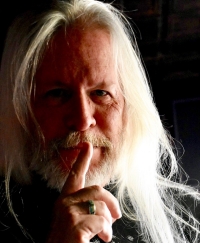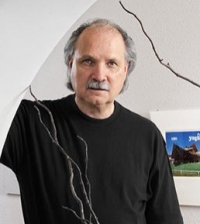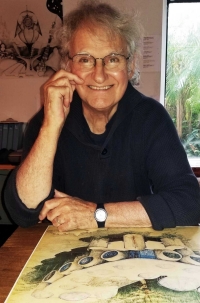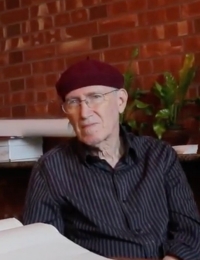
Renegades: The American School of Architecture
Stephanie Pilat, Division of Architecture
Luca Guido, Division of Architecture
"A new school, probably the only indigenous one in the United States" is how the architect Donald MacDonald once characterized the school of architecture that developed under the guidance of Bruce Goff and Herb Greene at the University of Oklahoma in the 1950s and '60s. At the time, architecture schools in the United States followed a curriculum inspired by either the French Beaux Arts school or the German Bauhaus school. On one hand, the French model centered on studies of classical principles of design and entailed meticulous copying of the great classical architecture of Greece and Rome. On the other hand, schools such as the Illinois Institute of Technology and the Harvard Graduate School of Design adapted the Bauhaus curriculum model-known for embracing industry and abstraction in art, architecture, and design-to the American context. Only the University of Oklahoma stood apart from these two trends and developed an original and authentically American approach to architecture and pedagogy.
This seminar on the American School examines the history of architecture at OU, Bruce Goff, who served as department Chairman in the 1940s and '50s, his architectural progenies, and the pedagogical experiment they fostered. This seminar grows out of the ongoing research project and exhibition, "Renegades: The American School of Architecture" which will open at the Fred Jones Jr. Museum of Art in 2020. A series of lectures will introduce the architectural context and projects of the American School as well as designers including Frank Lloyd Wright, Bruce Goff, Herb Greene, Bart Prince, and Violeta Autumn.
Under the leadership of Bruce Goff (1904-82), Herb Greene (b. 1929), Mendel Glickman (1895-1967), and many others, OU faculty developed a curriculum that emphasized individual creativity, organic forms, and experimentation. As MacDonald described, there emerged "a truly American ethic, which is being formulated without the usual influence of the European or Asian architectural forms and methodologies common on the East and West coasts of the United States." Indeed, the faculty rejected the rote copying of historical styles as well as the abstract minimalist approach popular elsewhere. Students were taught to look to sources beyond the accepted canon of western architecture and to find inspiration in everyday objects, the natural landscape, and non-western cultures such as the designs of Native American tribes of Oklahoma and the Western plains. This rejection of existing pedagogical models in favor of experimentation reflected Goff's own training. He was never formally educated in architecture; rather he learned architecture by doing it, having started in practice at the age of 12. The work of architects associated with the American School has been recognized around the world for its originality, organic forms, and poetic connection to landscape.
Public Lecture Series
View lecture series flyer
Robert L. Faust and the Design Build Approach

Monday, February 11, 2019
6:00 PM
Gould Hall 155
Christian Dagg
Head of the School of Architecture
Auburn University
Christian Dagg is the Head of the School of Architecture at Auburn University, where he teaches in the Architecture and Real Estate Development Programs. He received the Outstanding Faculty Award from the School of Architecture AIAS in 2002 and 2006, the CADC Outstanding Teaching Award in 2005 and the CADC Collaborative Initiative Award in 2004. More recently with his colleague Kevin Moore, he was a 2013 recipient of the NCARB Award for their project entitled “Studio: Urban Healthcare.” His recent research examines the pedagogy and practices of American School architect Robert Faust. Dagg is a principal of Hinson + Dagg Architects, a firm that has been recognized at the local and state level with AIA design awards. He has experience working for Machado and Silvetti Associates and Kallmann, McKinnell and Wood Architects. He holds a Masters in Architecture degree from the Harvard Graduate School of Design (1999 with Distinction) and a Bachelor of Science in Art degree from Northeastern University (1993 Magna Cum Laude).
Whatever Happened to the Future?

Monday, March 11, 2019
4:00 PM
Buskuhl Gallery, Gould Hall
Penelope Dean
Associate Professor
University of Illinois Chicago
Penelope Dean is associate professor at the UIC School of Architecture. Her research focuses on contemporary architectural culture with an emphasis on the exchanges between architecture and the allied design fields, including graphic, industrial, interior, and strategic design. Dean's writings have appeared in Architectural Design, the Journal of Architectural Education, Harvard Design Magazine, Log, hunch, Praxis, and Flat Out, and her research supported by The Graham Foundation for Advanced Studies in the Fine Arts and a visiting scholar’s residency at the Canadian Centre for Architecture, Montreal. She is founding editor of Flat Out.
American School Symposium

Monday, April 15, 2019
1:30 PM - 5:20 PM
Buskuhl Gallery, Gould Hall
Dr. Christopher Mead
Emeritus Regents’ Professor
University of New Mexico
Christopher Mead taught from 1980 to 2013 at the University of New Mexico, where he was a Presidential Teaching Fellow and Regents’ Professor with joint faculty appointments in the School of Architecture and Planning and the College of Fine Arts. From 2004 to 2009, he served as Dean of the College of Fine Arts. He received his B.A. summa cum laude from the University of California at Riverside, and both his M.A. and Ph.D. from the University of Pennsylvania. Past President and now a Fellow of the Society of Architectural Historians, he has published widely on European and American architecture and urbanism, including books on the American architects Robert Venturi, Bart Prince, and Antoine Predock, and the French architects Charles Garnier and Victor Baltard. He is currently writing a book on Japanese modern architecture after the bombing of Hiroshima.

Nelson Brackin
Architect and co-founder of Friends of Kebyar
Friends of Kebyar
Nelson Brackin first learned of Bruce Goff in 1972 from his Auburn University professor, Robert Faust. As a result, Brackin apprenticed with Goff in the mid-70s for 3 1/2 years. Brackin worked on several projects with Goff including the Price house and Warriner house. In 1983, Brackin was a founding member of the Friends of Kebyar, serving as its second president from 2000 to 2014. During his tenure, Brackin organized many of the group’s celebrations, including the 2004 Bruce Goff Centennial Celebration in Oklahoma, and Brackin served as the editor/writer of several journals, including the Bruce Goff Oklahoma Guide. Today, Brackin, has an independent architectural practice in Atlanta, Georgia, where he strives to create architecture based on the organic principles of truth, courage, and integrity. Brackin continues to share his knowledge of architecture by contributing to publications, such as the 2014 2nd edition of A Field Guide to American Homes, by Virginia McAlester, and now, the 2019 book by Ernest Burden, Bruce Goff’s Design Vocabulary: A synthesis of Music, Art and Architecture.

Arthur Dyson
Arthur Dyson has practiced architecture and environmental design in Fresno for over 40 years. During this time he has designed over 700 buildings, including several library facilities. His experience began while working with the legendary architect Frank Lloyd Wright in 1959 on the Marin County Civic Center, a 300,000 square foot government office complex in San Rafael, California; and the Guggenheim Museum in New York City. Dyson continued to work with architectural firms of note: Bartoli and Skinner, in Inglewood, California; Bruce Goff, Architect, in Bartlesville, Oklahoma; and William Gray Purcell, FAIA, in Pasadena, California. Since beginning his own practice in Fresno in 1969, he has produced award winning projects that have been published extensively. Mr. Dyson's design ability, sensitivity to materials and cost effective construction techniques have been recognized worldwide.

Ernie Burden
Architect
The American School
Ernest Burden was a student in an ivy-league school when he discovered an article in LIFE magazine featuring Bruce Goff's Ford house. He immediately transferred schools and ended up studying under BG for five years. His architecture and planning ventures transformed into workshops and publications helping other architects make effective presentations to their clients. He published Architectural Delineation, Entourage, Visionary Architecture, and several illustrated architectural dictionaries. He is finishing a new e-book: Bruce Goff's Design Vocabulary: A synthesis of Music, Art and Architecture.

Herb Greene
Herb Greene studied architecture at the University of Oklahoma with Bruce Goff, one of the nation’s most original and creative architects and an important architectural educator. Greene did many presentation drawings for Goff which are now in the Art Institute or Chicago. Greene also worked for John Lautner who was one of Frank Lloyd Wright’s original apprentices. Greene’s Oklahoma "Prairie House" caused an international sensation when it was published in color in Life and Look magazines, The London Time Journals, and journals throughout Europe and Japan. His residential work, following Goff’s, is dedicated to the expression the client’s favored colors, hobbies and interests, existential qualities such as the client’s personality and physiognomy as well as issues of site, region and the nature of materials. The Art Institute of Chicago, among the most prestigious art museums in the country, which holds the work of Sullivan, Wright, Goff and “The Prairie Tradition,” has accepted all of his architectural drawings and several of his collage paintings.

